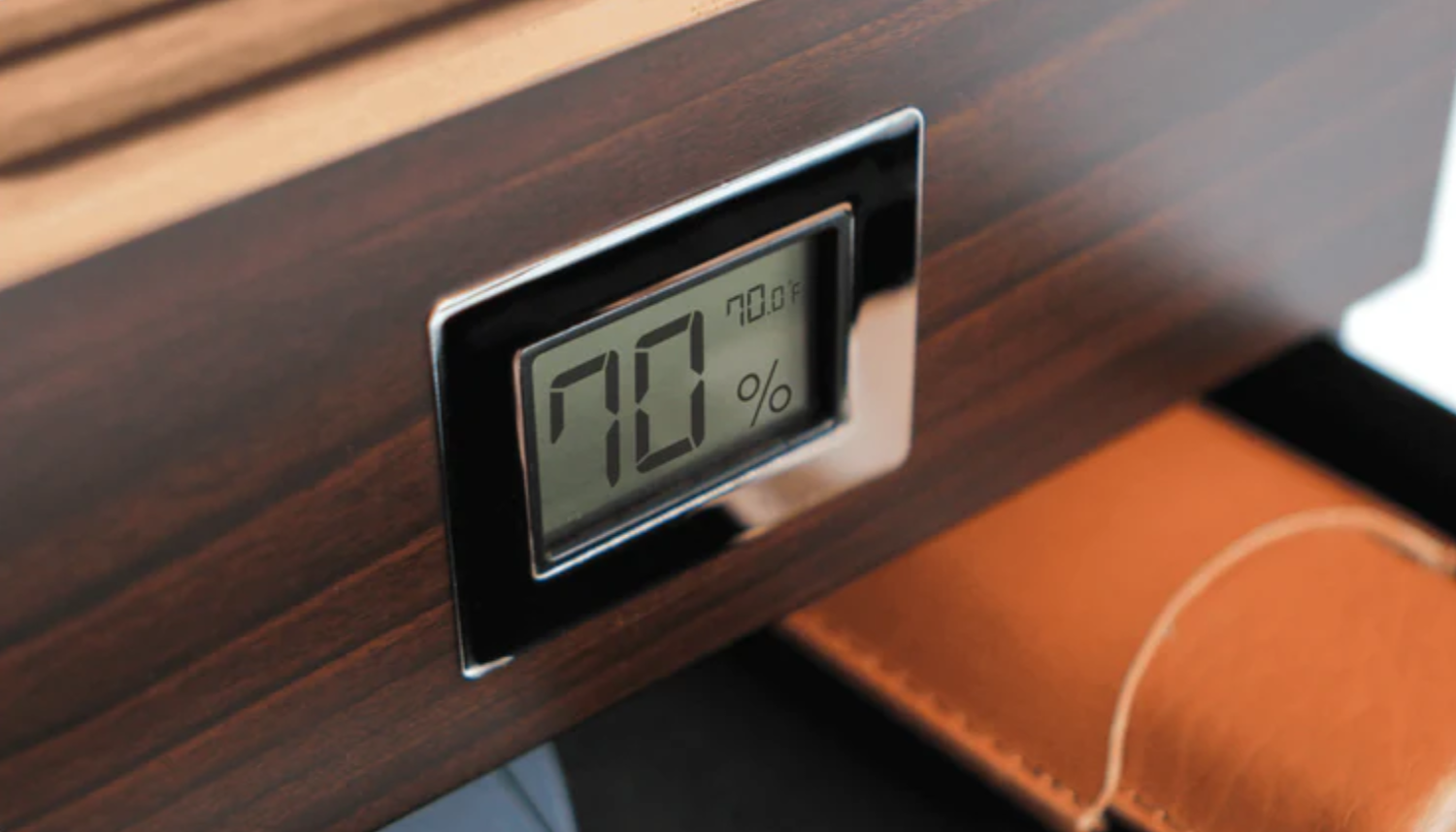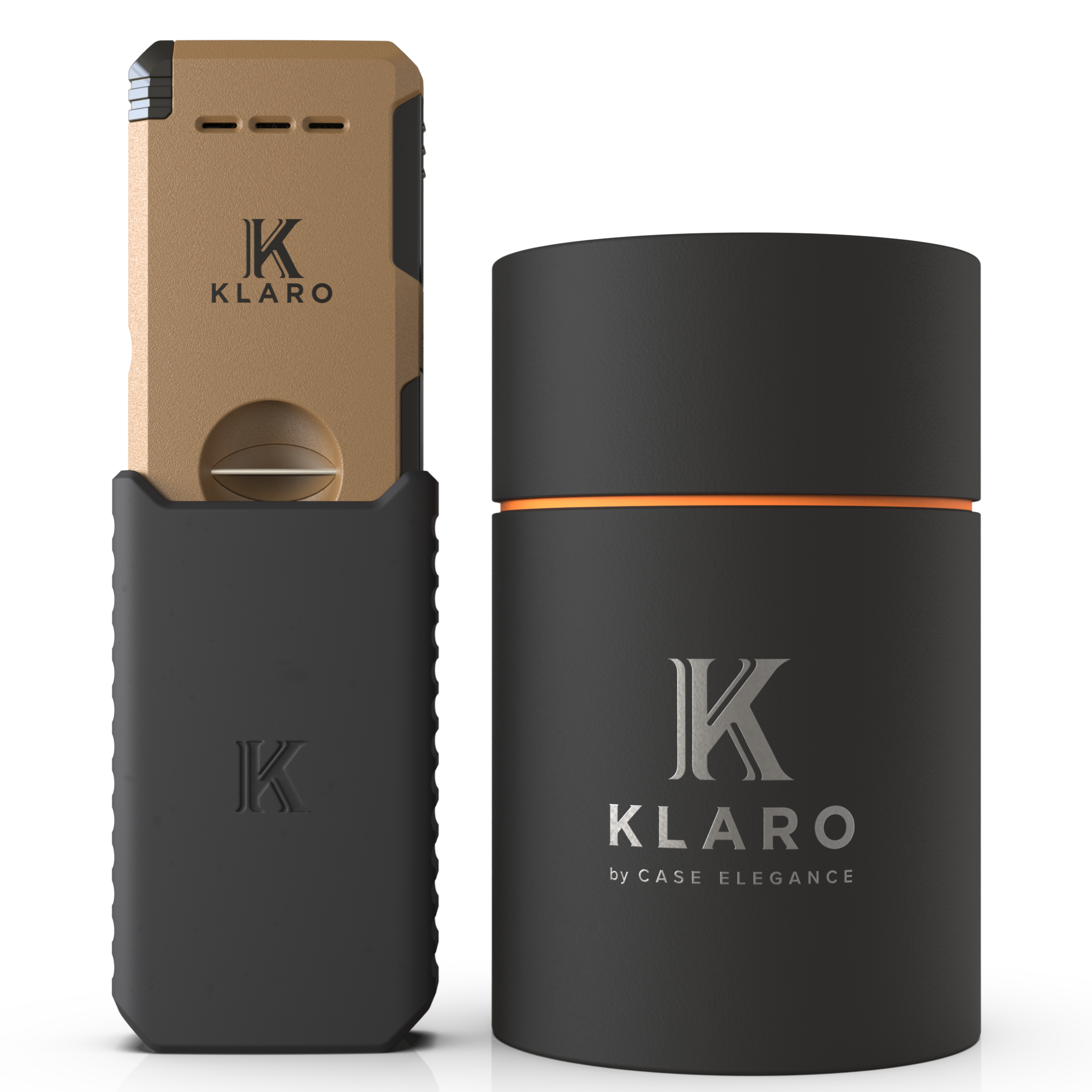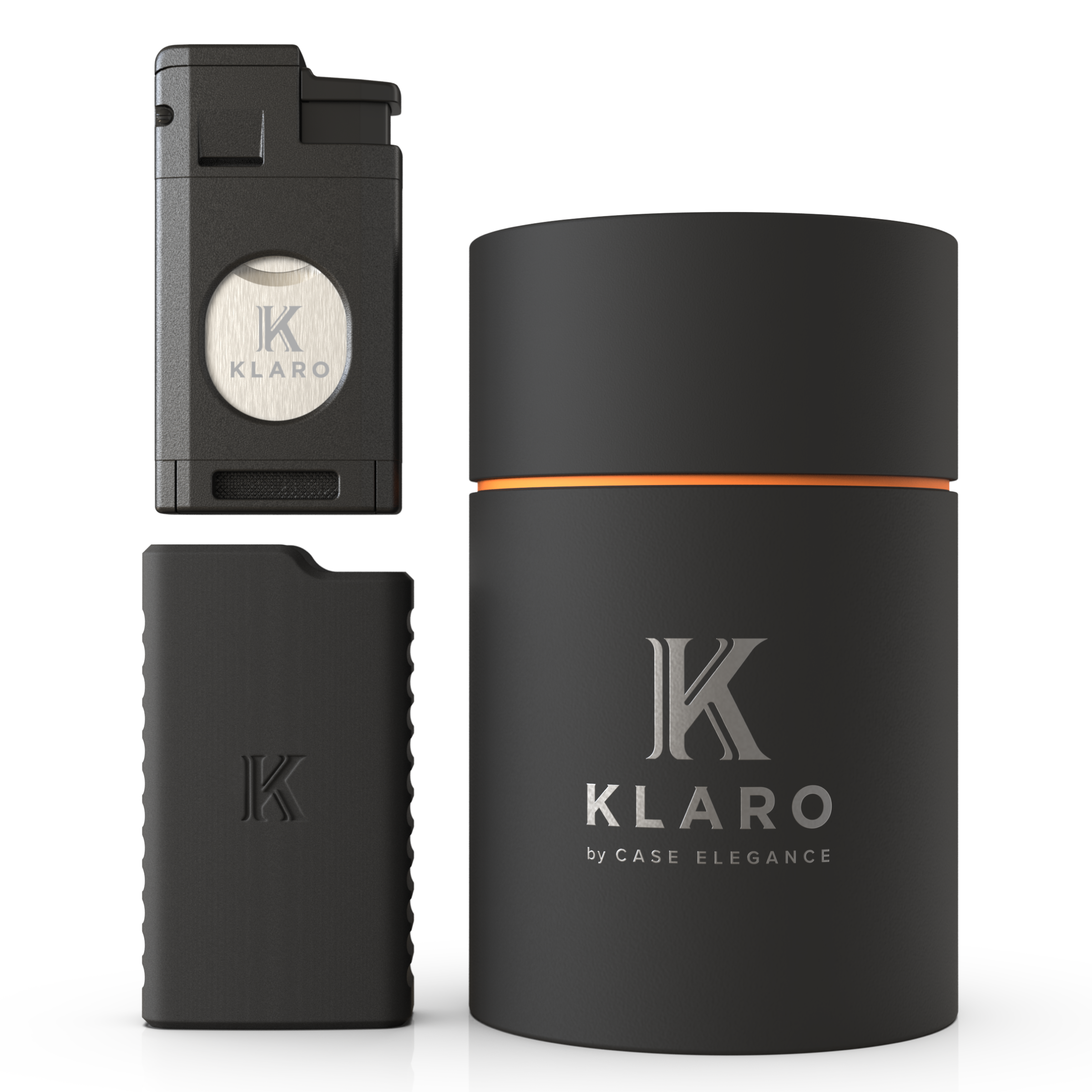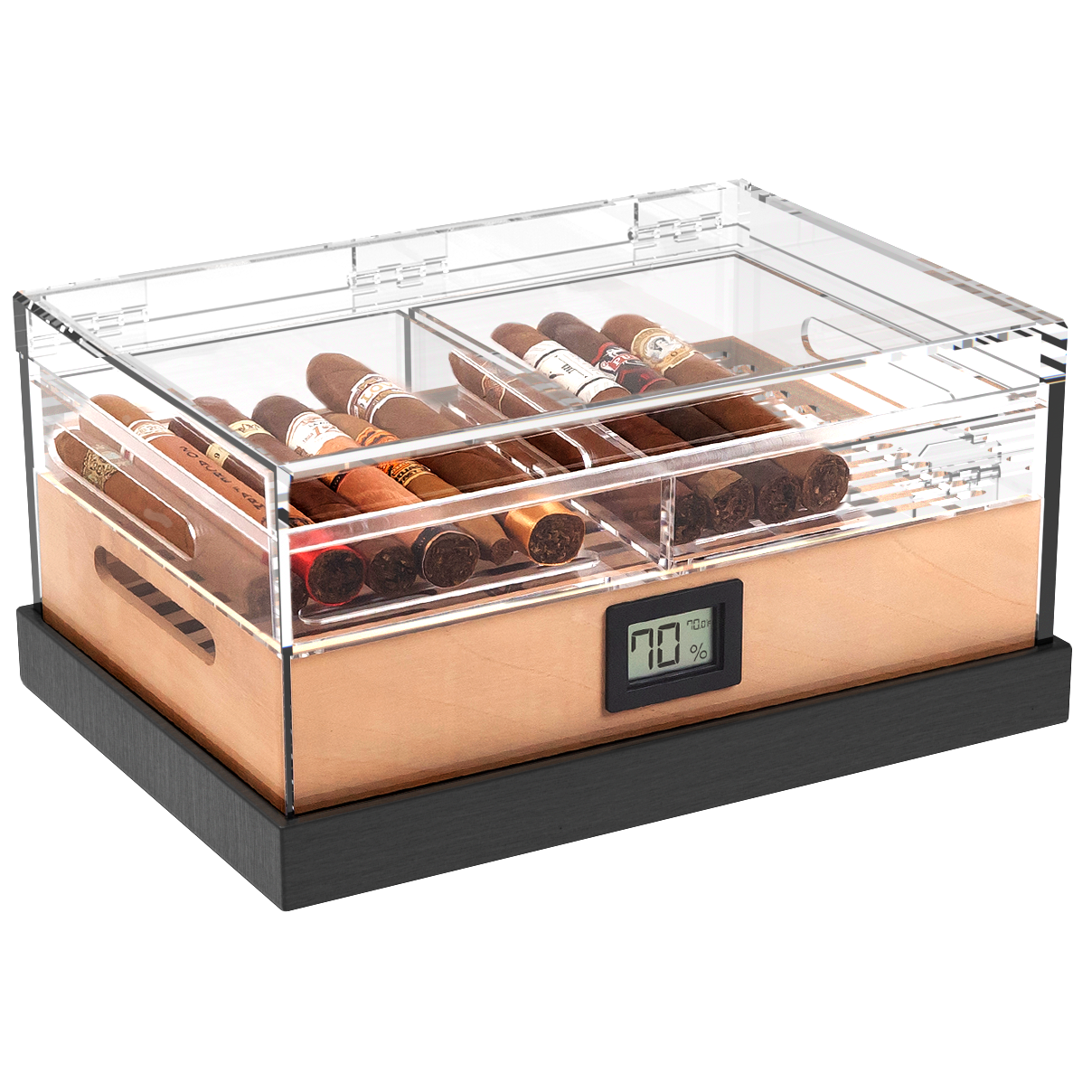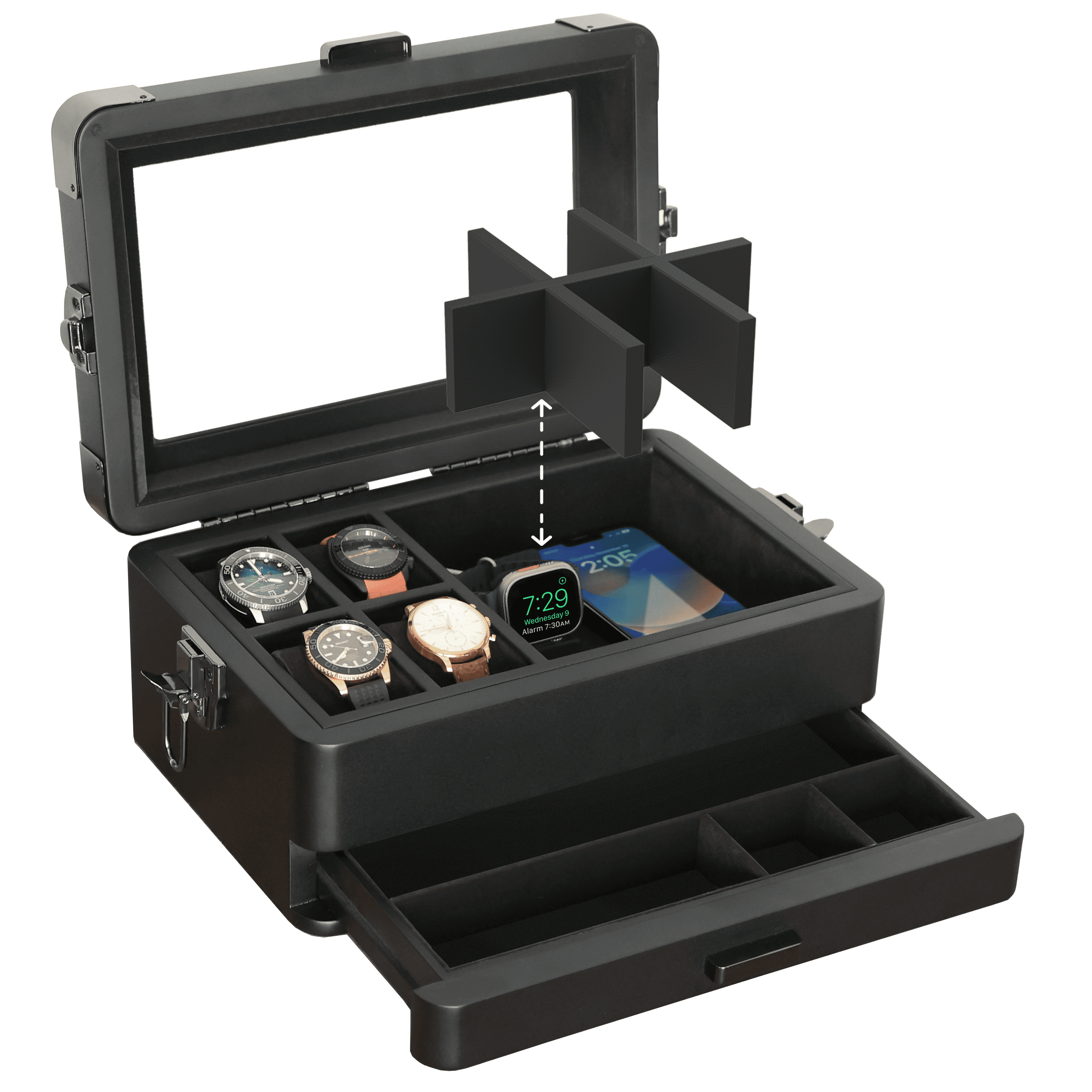Managing humidity levels is the single most important thing you can do to protect and preserve your cigar collection while enhancing their flavors and smokeability. Cigars are dynamic. Their flavors and physical attributes can change depending on the humidity levels they are stored at. Too humid or not humid enough, and cigars will dry out, mold, smolder when you smoke them, or burn unevenly. But if you can get the humidity right, you avoid a lot of headache and get the best experience when you smoke your cigars.
Humidors are the best tool to create the proper humidity levels for your cigars. Once you learn how do humidors work and dial in the correct humidity, you can store your cigars for longer and even age them to improve their flavors.
You should raise or lower the humidity within your humidor for two main reasons: First: because the outside air is especially humid or especially dry. In this instance, you may need to bolster your humidity levels, raising them initially, or lower them. Secondly, you may need to raise or lower the humidity if you are storing certain types of cigars or you are trying to manipulate their flavor profile. For example, flavored cigar types will generally do better at a higher humidity. Meanwhile, cigars you are aging should be stored at lower humidity levels.
We’ve previously covered how to lower the humidity in your humidor. In this article, we will investigate how to increase the levels of humidity within your humidor with humidor maintenance and humidor seasoning.
Assessing Your Humidor’s Current Humidity
First, how do you know what the humidity level is within your humidor? Getting an accurate humidity reading is the first step, and this requires an accurate hygrometer. A hygrometer measures the relative humidity inside your humidor. These tools are either analog or digital. We highly recommend a digital hygrometer, as the analog versions require calibration, which should only be done professionally.
But a humidor’s hygrometer is only as good as the seal of the humidor. The seal must remain airtight. Otherwise, outside air will enter the humidor and will both compromise the humidity levels and, therefore, the hygrometer’s reading.
The humidity inside your humidor should typically remain between 68%-72%. Sometimes you will want a lower humidity—as when aging cigars—but typically it will remain within this range. When your humidor falls well below those levels, you need to increase the humidity in your humidor.
Methods to Increase Humidity
A humidifier releases humidity into the air of your humidor. Humidors can have two different types of humidifiers: active or passive. Active humidifiers force humidification into the air, generally with fans, as with electric humidors or frigadors. Passive humidifiers release humidity naturally into the air through natural processes of osmosis and evaporation.
Passive humidifiers include humidifier packs, gel beads and crystal humidifiers, and humidor solution. At its most basic form, you could put a shot glass filled with distilled water in your humidor to act as a passive humidifier. Each method slowly increases the humidity in the humidor.
With active humidifiers, you can increase humidity levels quicker, but this may be rougher on your cigars than if the humidity increases slowly and naturally as with a passive humidifier. Avoid raising humidity levels too quickly as this can cause physical damage to the cigars.
Regardless of the type of humidifier your humidor uses, you can help bolster humidity levels with a few DIY tricks that are easy and safe. Just note that if you increasingly need to bolster humidity, it may be that your humidor is not equipped with the right type of wood (Spanish cedar) to retain humidity and respond to fluctuations in outside humidification levels. That, or your seal may be compromised.
DIY Solutions for Humidity Control
To
Our first recommended DIY humidity control: sponge and distilled water method. Simply soak and then ring-out a sponge with distilled water. Place the sponge on a small try to not expose the humidor elements to moisture, and then observe any humidity fluctuations with your hygrometer over the next 24 hours. You may need to repeat this process.
Next, you can also use household items to bolster the humidity levels in your humidor. Fill a small bowl with distilled water and place this inside of your humidor uncovered. Just like the method of filling a shot glass with distilled water, the bowl will allow small amounts of water to evaporate and absorb into the wood of the humidor to release when humidity levels drop.

Environmental Factors and Humidor Placement
Beyond increasing the humidity levels through the humidifier or with DIY methods, you can give your humidor a leg up with a few practical steps. For example, where you store your humidor can impact how well it protects your cigars. In general, avoid locations that may expose the humidor to temperature fluctuations. Ideally, you won’t place your humidor near an air conditioner, heater, or a window, where sunlight may cause the temperature to rise.
Avoid storing your humidor in any room of your house that is affected by seasonal changes, (i.e., rooms prone to getting cold in the winter or hot in the summer). Additionally, the room where you store (and therefore open) your humidor should be kept at a consistent humidity level. Room humidifiers and dehumidifiers may help you moderate those levels.
Lastly, consider how often your humidor is getting opened. The more frequently you open the top and expose your humidor to the exterior humidity and temperature, the more the humidor will have to work to recalibrate itself. If you have your humidor in a public area where guests may be prone to open it, consider a ガラストップヒュミドール that allows them to see your collection without opening the box.
Advanced Techniques for Humidity Control
ヒュミドールのシーズニング is the single most important thing you can 為さる to your humidor to get its best performance. Seasoning is the act of bolstering the wood inside your humidor with enough humidity that it can respond effectively when you add a lot of cigars or when the exterior humidity levels drop.
我々は以下を提供する step-by-step seasoning instructions for most Klaro humidor models. But the basic premise is fairly straightforward:
- Using Klaro ヒュミドール液, wet a paper towel and wipe the inside Spanish cedar with humidor solution.
- Fill your humidifier with humidor solution and leave in the humidor until it reaches at least 68% for 1-3 consecutive days.
- Add crystals to your humidor solution and observe for any all in humidity level. Add more solution if needed.
- Add cigars and observe for consistent humidity levels.
While this is a fairly simple process, it helps the long term performance of your humidor by saturating the wood with a formidable amount of excess humidity. That way, when the cigars you add soak up the humidity in the air, the Spanish cedar humidor wood will release its reserves.
Wondering why you need to use humidor solution? Humidor solution is made of propylene glycol solution, which actually stops saturating the air with moisture once relative humidity reaches 70%. This way, you don’t go too far in humidifying your cigars.
Many cigar smokers incorporate the use of Boveda humidor packs, which are helpful in bolstering humidity levels in your humidor. These can be used in addition to your humidifier to increase humidity levels, just be cautious that you don’t oversaturate the humidor with moisture.

Troubleshooting Common Humidity Issues
So how do you know if your humidor’s humidity is too high or low? Well, your hygrometer is your best line of defense. If its sensors are sealed correctly (and your humidor is sealed correctly), it should provide you an accurate reading, and you want anything between 68-72% humidity. But problems can occur, and your hygrometer may not be accurate. Look for these tell-tale signs that your humidity levels are too high or low.
Too high:
- Cigars become soft to the touch and tobacco does not spring back when you pinch it.
- Cigars are more prone to smolder or smoke unevenly when lit.
- Cigars develop mold.
Too low:
- The tobacco inside the cigars become brittle and you detect crackling.
- Cigars smoke unevenly and are prone to canoeing or tunneling.
- The cigar wrappers begin to crack.
Resolving Low Humidity Levels:
If the humidity becomes too low, make sure your humidor solution is replenished. In extreme cases, add humidor solution, humidor packs, and an open distilled water container to try to increase humidity levels. But please monitor the situation closely as you may push the humidity levels too high.
Resolving High Humidity Issues
If your humidor becomes too humid, you may need to temporarily remove the humidifier or leave open the humidor lid for an extended period of time until the levels drop.
Best Practices for Humidor Maintenance
A good humidor should sustain its humidity levels for an extended period of time. But even the best humidors require routine preventative maintenance.
First and foremost, monitor your humidity levels to detect significant humidity level changes before they damage your cigars. You can do this manually, keeping a close eye on the hygrometer. But this maクラロ・バレー Smart Humidor which makes it easy to monitor your humidor from your smartphone. Easy, convenient, and potentially money-saving, this is a great way to keep tabs on your humidor.
You may need to regularly add humidor solution to your humidor, especially if you frequently add new cigars. As new cigars are added, they will take humidity from the wood and your humidifier—as they are supposed to—and you need to replenish those sources with humidor solution. Monitor those levels once a month.
To clean your humidor, we recommend occasionally wiping the inside with a slightly moist towel, preferably when you re-season your humidor, which we recommend. Use distilled water for this process and avoid saturating the wood with any moisture.
Lastly, there are a few common mistakes to avoid and tips to follow when storing cigars in your humidor.
- Do not overpack your humidor. Adding too many cigars to your humidor will make it nearly impossible to achieve consistent humidity levels. Either purchase another humidor or upgrade to a humidor large enough to house the amount of cigars you wish to keep on hand.
- Create a humidor solution schedule. Don’t forget routine refills. Create a schedule so you know when the last time you refilled and how long until your next refill.
- Avoid wiping your humidor walls with solution.
- Consider the hygrometer placement. The closer the hygrometer is to your humidifier, the higher the reading will be. Make sure the hygrometer reading is reflective of the general condition.
- Rotate your cigars. Moving your cigars around in your humidor every few weeks will allow them to be exposed to different proximities to the humidifier, which should help them keep a
結論

As you monitor your humidor, add cigars, and experiment with different humidity levels, you will learn many lessons about how to operate and maintain your humidor, including how to lower or increase humidity levels as needed. The good news? You have already won the battle by storing your cigars in a dedicated humidor, and now the process simply dials in the exact ideal environment.
And for more information, explore our Frequently Asked Questions below.
How Often Should I Check My Humidor’s Humidity?
You should regularly monitor your humidor for fluctuations in humidity levels, especially during seasonal switches or when the outside humidity levels or temperatures have fluctuated recently. You should also closely monitor your humidor’s humidity levels in the first 24-36 hours after adding new cigars to your collection, as these new additions may absorb humidity within the humidor.
What is the Ideal Humidity Level for Cigars?
We recommend you store your cigars between 68-72% relative humidity. In some cases, you may opt to go above or below this, as in the case with flavored cigars or when aging certain cigars. But humidity levels outside this range pose some danger to your collection.
Can I Use Tap Water in My Humidifier?
While we recommend humidor solution be used in your humidor and your humidifier, distilled water is the next best option, which is free from chemicals like chlorine found in tap water. These chemicals may interfere with your humidor's performance.
How Do I Know if My Humidor Needs Seasoning?
If you begin to detect that your humidor is not able to hold consistent humidity levels without frequent humidor solution refills or that it quickly dips in humidity when you add a few cigars to your collection, it’s likely time to re-season your humidor.
What Should I Do if My Humidor Smells Musty?
Regular maintenance is important for any humidor. Monitor it frequently to ensure its humidity levels are correct, and also inspect for the potential of mold or musty smells that might indicate the interior has been compromised. If you smell anything musty, remove the cigars and humidifier and clean the inside with a soft cloth or sponge made damp with distilled water.

